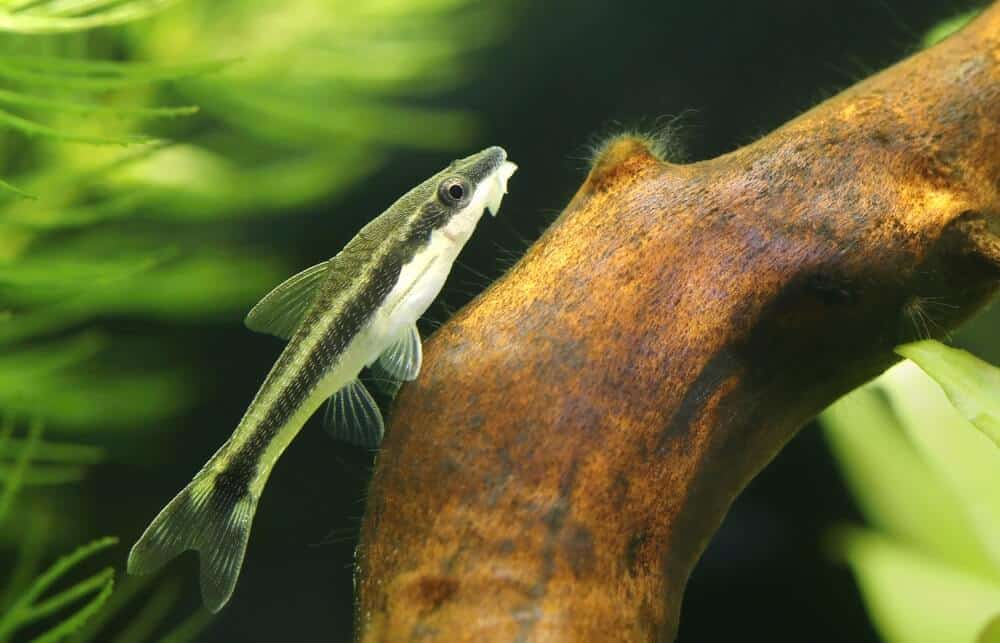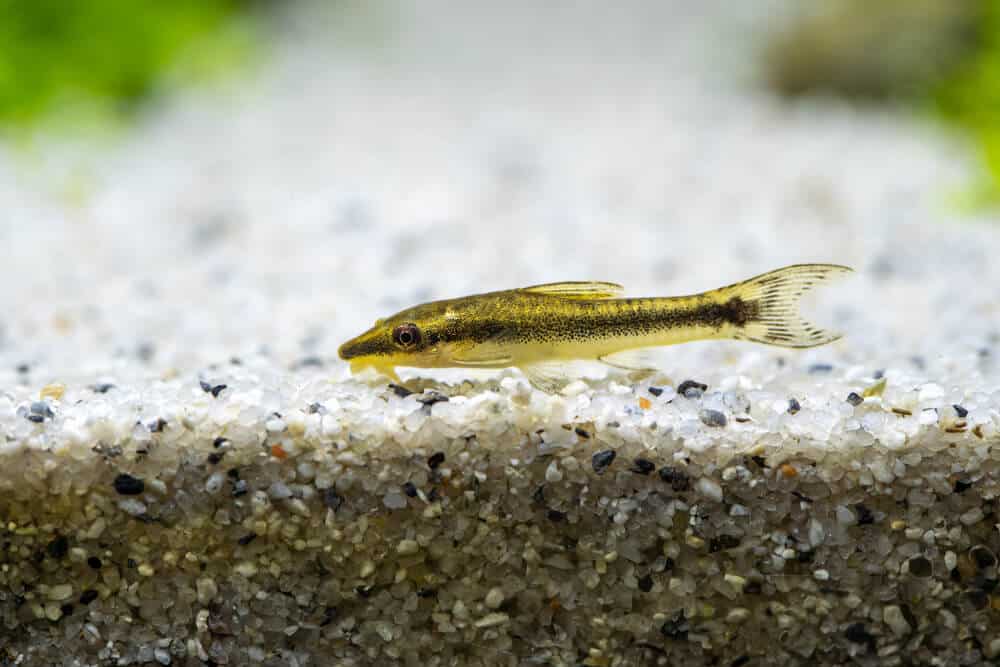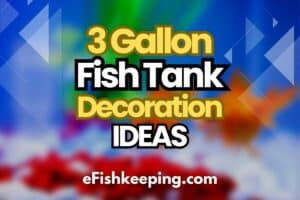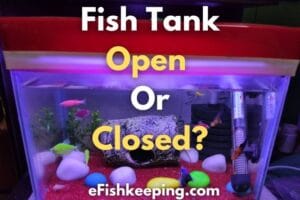Otocinclus catfish are pretty good at cleaning aquarium glass. They have suction cup style mouth structure which enables them to easily clean algae from the glass.
But do they just clean glass? What about other parts of the tank like plants and rocks? And what to do if they are not cleaning your glass as effectively as you’d expect? Keep reading till the end to find out.
What Makes Otocinclus Effective at Cleaning Glass?

1. Specialized Mouth Structure
Otos have a unique mouth designed like a suction cup. This allows them to stick to surfaces firmly, including your aquarium’s glass walls. Once attached, they can easily scrape off algae without being dislodged.
2. Efficient Algae Eaters
Algae, the greenish layer you often see on aquarium glass, is the primary diet of otos. They are voracious algae eaters. This natural feeding habit makes them efficient cleaners, keeping the glass free from unsightly algae build-ups.
3. Size and Agility
Otocinclus catfish are small (only up to 2 inches long) and agile. This means they can reach areas of the glass that larger fish like pleco can’t. Their small size also allows them to clean without disturbing other tank inhabitants or uprooting plants.
4. Non-Aggressive Nature
Being peaceful creatures, otos won’t disturb other fish while they do their cleaning job. This harmony is essential in a community tank where stress can impact the health of all fish.
5. Efficiency at Various Depths
Interestingly, otos are known to clean at all levels of the tank. They’re as effective at cleaning the lower regions near the substrate as they are at higher, more visible glass areas. This adaptability ensures a uniformly clean tank.
Pro-Tip: If you’re looking for bottom cleaner fish, then Cory catfish are a better choice over Otos.
What Are the Limitations of Otocinclus in Cleaning Aquarium Glass?
While Otocinclus catfish are excellent at keeping your aquarium glass clean, they do have limitations. Understanding what types of algae they can and cannot effectively clean is key for maintaining a healthy aquarium. Here’s a simple table to illustrate this:
| Effective in Cleaning | Not Effective in Cleaning |
| Diatoms (Brown Algae) | Black Beard Algae |
| Soft Green Algae | Green Spot Algae |
| Hair Algae |
Explanation of Algae Types:
- Diatoms (Brown Algae) – This type of algae is common in new tanks and appears as a brown film on glass and decorations. Otos are particularly good at cleaning this because it’s soft and easy for them to scrape off.
- Soft Green Algae – This algae forms a slimy layer and is another favorite of Otocinclus. They can easily consume this algae, keeping your glass clear.
On the other hand, Otocinclus struggle with:
- Black Beard Algae – This algae is tough and clings tightly to surfaces. Otos find it difficult to scrape off due to its hard texture. Siamese Algae Eaters are great at keeping black beard algae in control.
- Green Spot Algae – This algae forms hard green spots, particularly on glass, which Otocinclus can’t effectively clean because it’s too tough for their mouths. Green spot algae are one of the toughest algae to remove for any fish or snails. So the best approach is to manually scrub them off the tank surface and decorations.
- Hair Algae – This long, stringy algae is challenging for Otocinclus to grasp and remove. You can add Nerite snails to take care of hair algae, as they are quite effective in cleaning that type of algae.
Why Otocinclus Not Cleaning Aquarium Glass And What Can You Do About It?

Sometimes, you might notice that your Otocinclus catfish aren’t cleaning the aquarium glass as effectively as you expected. This is normal, and there are a few reasons why it happens:
When you first bring Otocinclus home, they may initially clean the glass enthusiastically, munching away the existing algae. This happens because they might not have eaten well before. However, after this initial burst of activity, their cleaning pace can slow down.
Don’t worry, though—they are still at work. You’ll notice cleaner plants and clearer glass over time.
Presence of Aggressive Tank Mates
If there are other aggressive fish in the tank, Otos might feel a bit uncomfortable going near those tank mates. Being peaceful creatures, they tend to stick to certain areas, avoiding conflict.
This behavior might prevent them from reaching parts of the glass, especially if more dominant fish occupy those regions.
Algae Type Limitation
Otocinclus aren’t effective against all types of algae. This is where complementary tank mates come in. Consider adding snails or shrimp, which can target algae types that Otos can’t handle.
It’s essential to remember that Otos are not the only solution to keep the tank glass clean. Continue with your routine tank maintenance, including scrubbing the glass and cleaning decorations.
What Other Aquarium Fish or Snails Complement Otocinclus in Cleaning?
While Otocinclus catfish are great at keeping your aquarium glass clean, pairing them with other species can enhance the overall cleanliness of your tank. Here are some aquarium companions that work well with Otocinclus:
- Nerite Snails – These snails are excellent at cleaning glass, plants, and decorations. They are particularly good at cleaning green and brown algae from the tank.
- Amano Shrimp – Known for their appetite for algae, Amano shrimp can access small crevices that fish might miss. They’re especially effective against hair algae.
- Siamese Algae Eater (SAE) – SAEs are great for controlling algae growth, including the more challenging types like black beard algae. They are peaceful and can coexist well with Otocinclus.
Interested in more detailed information on the best glass cleaner fish for aquariums? Be sure to check out my comprehensive guide.
Final Thoughts
To effectively manage algae in your tank, consider a few more things alongside adding Otos.
Too much light, especially direct sunlight, can accelerate algae growth in your aquarium. It is for this reason why you want to avoid keeping fish tanks near windows.
Monitor and adjust your tank’s lighting. Aim for a balance that keeps your plants and fish healthy without giving algae a chance to grow.
Also, take note of the excess nutrients resulting from overfeeding or overuse of fertilizers. Overfeeding your fish not only affects the water quality but also leaves more waste which acts as a food for the algae. So add only an adequate amount of food and nutrients in the tank.
In a nutshell, aim for a balanced ecosystem in your aquarium. This includes having the right mix of fish, plants, and other aquatic life that works together to keep the environment healthy and clean.
FAQs
How Many Otocinclus To Get For My Fish Tank?
2-3 should be enough to keep your fish tank glass clean. But choose the number depending on your tank size. As a rule, you can keep up to Otos in a 10 gallon tank and up to 4 Otos in a 20 gallon. So choose the number of Otocinclus catfish accordingly.
Learn More In Detail: How Many Algae Eaters To Have In A Fish Tank?
How To Keep Algae Off My Fish Tank Glass?
Keeping algae off your fish tank glass involves a combination of strategies: Limit the amount of light your tank receives, especially direct sunlight. Aim for about 8-10 hours of light per day. Avoid overfeeding, use algae eaters, perform regular water changes, and follow a regular fish tank cleaning schedule.
Hi! I’m Praveen Ghoshal, the founder of eFishkeeping.com. Inspired by my Dad, I got interested in fishkeeping when I was a kid. Since then, I have been involved with this hobby. Currently, I have 3 fish tanks at our home, and I enjoy this hobby with my full family. Read more about me here.








